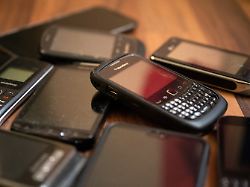gold, copper and nickel
Urban mine hides huge treasure trove of raw materials
01/16/2023 11:38 am
There is currently a real pot of gold in German drawers – according to estimates, the value of the metal from unused cell phones is around 240 million euros. In order to “mine” the valuable raw materials, a new urban mining strategy is now to be developed.
When the smartphone has had its day, it often ends up in a drawer – “you can always use it again”. According to the Bitkom digital association, around 210 million old cell phones were stored in households in Germany last year. 87 percent of citizens had at least one discarded mobile phone. That number has more than doubled since 2015.
The drawer cell phones belong to the so-called urban mine. In contrast to the classic raw material mine, it describes the man-made raw material deposits: “All goods that we humans have ever created,” explains Britta Bookhagen from the Federal Institute for Geosciences and Natural Resources (BGR). These so-called anthropogenic camps include bridges, cars, houses, washing machines – and also smartphones. Gold, copper and nickel can be extracted from mobile phones, for example, and steel in particular from cars and bridges.
“Enormous stocks of material accumulated”
When strategically considering the urban mine, it is initially irrelevant “whether the goods are still being actively used and will only be released in the foreseeable future or whether they have already reached the end of their useful life,” writes the Federal Environment Agency (UBA) on its website. Metals and construction minerals in particular often remain in infrastructure, buildings and everyday goods for a long time. “In this way, enormous stocks of material have been accumulated over decades, which hold great potential as a future source of secondary raw materials.”
According to the UBA, the German economy uses around 1.3 billion tons of materials domestically every year – this includes products such as cars as well as pure raw materials. The Federal Republic of Germany is heavily dependent on imports, especially for metal and energy raw materials, as can be seen from the latest BGR raw materials situation report from December. Especially when it comes to newly mined metals, Germany is almost completely dependent on imports.
But: The raw materials in the world are finite, international competition is growing, costs are rising – as is the pressure on natural areas and their ecosystems. The recycling of metals or building materials, for example, can therefore help to conserve the earth’s natural resources – and at the same time reduce greenhouse gas emissions, groundwater pollution and biodiversity loss, says Felix Müller, who is responsible for urban mining at the Federal Environment Agency. And an expansion not only helps the environment: “The vision is to become less dependent on raw material imports. Rather, we should become veritable raw material producers with secondary extraction. In this way we can also open up a new economic field,” says Müller. According to him, the anthropogenic stocks of Germany are enriched with around 550 million tons of material per year.
potential of a circular economy
The expert says: “As long as the stocks of materials are growing so much, we are still a long way from a sustainable circular economy. But the growing stock holds the immense potential to close material cycles much better in the future than we have been able to do so far. We have to set the course for this now and adjust framework conditions.” The federal government is therefore currently working on a national urban mining strategy.
“Mining” in the urban mine is not done with a bucket wheel excavator and pickaxe, but through recycling – and thus to a certain extent it is also a task for society as a whole, says the geologist Bookhagen. But she makes it clear: “Urban mining refers to products at the end of their lives.” Only when all other ways, such as repairing or reselling, have been exhausted, does recycling start – “please don’t put it in the drawer,” says Bookhagen. There is currently a veritable pot of gold in the German drawers. In a study from 2020, Bookhagen and her colleagues came to the conclusion that the around 200 million smartphones in German drawers contain around 3.4 tons of gold, 1300 tons of copper and 520 tons of nickel.
In a report, researchers at the Institute of German Economics in Cologne calculated that the value of the metal in unused cell phones is around 240 million euros. With a view to the material value of the smartphones sold in 2021 of 23.5 million euros, the drawer phones could cover the material requirements for new smartphones for more than ten years. However, the authors limit the calculation themselves: The reality is different, “because not all drawer cell phones are recycled and are also completely recyclable”.
“The urban camp is growing”
That is exactly the greatest difficulty in urban mining, says expert Bookhagen: “It is very difficult to estimate which raw materials will come back to us and when.” On the one hand, it is not at all clear how much steel or aluminum was used in a car or a washing machine 50 years ago, nor how it makes the most sense to recover and process it. Better data is needed here. “One thing is certain: the urban warehouse is growing and has a high recyclable content.”
The extraction of raw materials from the urban mine has a lot of potential to become less dependent on raw material imports and rising costs, says Bookhagen. Germany and Europe are doing well compared to other parts of the world. “But one mustn’t forget: Even if we could get everything out of the urban mine, that wouldn’t cover our raw material requirements,” the expert continues. The hunger for raw materials is too great for that.
